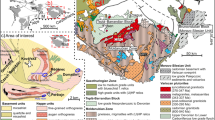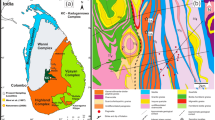Abstract
The complex microstructure of kelyphitic rims around garnet in lower crustal garnet granulite xenoliths from the Bakony–Balaton Highland Volcanic Field, Central Pannonian Basin has been studied in order to identify controls on garnet breakdown. Symplectites comprised of a vermicular intergrowth of submicron sized anorthite, orthopyroxene and spinel replace garnet at a sharp reaction front. Based on element distribution maps the transformation of garnet to symplectite is isochemical. Phase diagram calculations indicate that this reaction was induced by a pressure decrease and/or a temperature increase. In site-specific TEM foils prepared by focused ion beam technique and oriented parallel and perpendicular to the reaction front 200 nm wide rods of anorthite and 20 nm wide rods of spinel are identified. The rods are oriented approximately perpendicular to the replacement front and are embedded in an orthopyroxene matrix. The regular spacing of the symplectite phases along the reaction front suggests that their growth is controlled by diffusion. The kinetics of symplectite formation has been modelled based on irreversible thermodynamics. During interaction of the xenolith with the host basalt the microstructure and chemistry of the An–Opx–Spl symplectite was significantly modified and it was partially replaced by an olivine bearing symplectite. In contrast to primary symplectite formation, these processes were metasomatic in nature including addition of sodium, titanium and some trace elements from the basaltic melt and can clearly be discerned from the garnet breakdown. Based on these observations it is inferred that symplectite formation took place within the deep crust during the extension of the Pannonian Basin between 15 and 30 km depth at high temperature (850–1,050°C) prior to the volcanic transport to the surface.










Similar content being viewed by others
References
Abart R, Petrishcheva E, Fischer FD, Svoboda J (2009) Thermodynamic model for diffusion controlled reaction rim growth in a binary system: application to the forsterite-enstatite-quartz system. Am J Sci 309:114–131
Ai Y (1994) A revision of the garnet-clinopyroxene Fe2+–Mg exchange geothermometer. Contrib Mineral Petrol 115:467–473
Altherr R, Kalt A (1996) Metamorphic evolution of ultrahigh-pressure garnet peridotite from the Variscan Vosges Mts. (France). Chem Geol 134:27–47
Anders E, Grevesse N (1989) Abundances of the elements: meteoric and solar. Geochim Cosmochim Acta 53:197–214
Arculus RJ, Smith D (1979) Ecologite, pyroxenite, and amphibolite inclusions in kimberlites and other volcanics in Sullivan Buttes latite, Chino Valley, Yavapai county, Arizona. In: Boyd FR, Meyer HOA (eds) The mantle sample. American Geophysical Union Monograph, Washington, pp 309–317
Ashworth JR, Chambers AD (2000) Symplectitic reaction in olivine and the controls on intergrowth spacing in symplectites. J Petrol 41(2):285–304
Ashworth JR, Sheplev VS (1997) Diffusion modeling of metamorphic layered coronas with stability criterion and consideration of affinity. Geochim Cosmochim Acta 61:3671–3689
Cahn JW (1959) The kinetics of cellular segregation reactions. Acta Metall 7:18–28
Carswell DA, Moiler C, O’Brien PJ (1989) Origin of sapphirine-plagioclase symplectites in metabasites from Mitterbachgraber, Dunkelsteinerwald granulite complex, Lower Austria. Eur J Mineral 1:455–466
Connolly JAD (1990) Multivariable phase diagrams: an algorithm based on generalized thermodynamics. Am J Sci 290:666–718
Csontos L, Nagymarossy A, Horváth F, Kovács M (1992) Tertiary evolution of the Intra-Carpatian area: a model. Tectonophysics 208:221–241
Dégi J, Török K (2003) Petrographic evidence of crustal thinning in Bakony–Balaton Highland Volcanic Field (in Hungarian with English abstract). Magy Geofiz 44:125–133
Dégi J, Abart R, Török K, Rhede D, Petrishcheva E (2009) Evidence for xenolith–host basalt interaction from chemical patterns in Fe–Ti-oxides from mafic granulite xenoliths of the Bakony–Balaton Volcanic field (W-Hungary). Mineral Petrol 95(3–4):219–234
De Jong AF, Coene W, van Dyck D (1989) Image processing of HRTEM images with non-periodic features. Ultramicroscopy 37:53–66
Dövényi P, Horváth F (1988) A review of temperature thermal conductivity and heat flow data from the Pannonian Basin. In: Royden LH, Horváth F (eds) The Pannonian Basin. American Association of Petroleum Geologists Memoir 45, Tulsa, pp 195–233
Droop GTR (1987) A general equation for estimating Fe3+ concentration in ferromagnesian silicates and oxides from microprobe analyses, using stoichiometric criteria. Mineral Mag 51:431–435
Dudeck A, Fediukova E (1974) Eclogites of the Bohemian Moldanubicum. Neues Jahrb Mineral Abh 121:127–159
Eckert JO Jr, Newton RC, Kleppa OJ (1991) The ∆H of reaction and recalibration of garnet-pyroxene-plagioclase-quartz geobarometers in the CMAS system by solution calorimetry. Am Mineral 76(1/2):148–160
Embey-Isztin A, Downes H, James DE, Upton BGJ, Dobosi G, Ingram GA, Harmon RS, Scharbert HG (1993) The petrogenesis of Pliocene alkaline volcanic rocks from the Pannonian Basin, Eastern Central Europe. J Petrol 34(2):317–343
Embey-Isztin A, Downes H, Kempton P, Dobosi G, Thirlwall M (2003) Lower crustal xenoliths from the Pannonian Basin, Hungary. Part 1: mineral chemistry, thermobarometry and petrology. Contrib Mineral Petrol 144:652–670
Fiala J (1966) The distribution of elements in mineral phases of some garnet lherzolites from the Bohemian massif. Krystalinikum 4:31–53
Fodor L, Csontos L, Bada G, Győrfi I, Benkovics L (1999) Tertiary tectonic evolution of the Pannonian Basin system and neighbouring orogens, a new synthesis of paleostress data. In: Durand B, Jolivet L, Horváth F, Séranne M (eds) The Mediterranean Basins: Tertiary extension within the Alpine Orogen. Geological Society, London, Special Publications 156, pp 295–334
Foley SF, Andronikov AV, Jacob DE, Melzer S (2006) Evidence from Antarctic mantle peridotite xenoliths for changes in mineralogy, geochemistry and geothermal gradients beneath a developing rift. Geochim Cosmochim Acta 70:3096–3120
Ganguly J, Cheng W, Chakraborty S (1998) Cation diffusion in aluminosilicate garnets: experimental determination in pyrope-almandine diffusion couples. Contrib Mineral Petrol 131:171–180
Géczy B (1973) The origin of the Jurassic faunal provinces and the Mediterranean plate tectonics. Ann Univ Sci Budap Rolando Eotvos Nom Sect Geol 16:99–114
Godard G, Martin S (2000) Petrogenesis of kelyphites in garnet peridotites: a case study from the Ulten zone, Italian Alps. J Geodyn 30:117–145
Griffin WL, Heier KS (1973) Petrological implication of some corona structures. Lithos 6:315–335
Harangi Sz (2001) Neogene to Quatenary volcanism of the Carpatian–Pannonian Region—a review. Acta Geol Hung 44:223–258
Holland TJB, Powell R (1998) An internally consistent thermodynamic data set for phases of petrological interest. J Metamorph Geol 16:309–343
Horváth F (1993) Towards a mechanical model for the formation of the Pannonian Basin. Tectonophysics 226:333–357
Horváth F (1995) Phases of compression during the evolution of the Pannonian Basin and its bearing on hydrocarbon exploration. Mar Petrol Geol 12(8):837–844
Huismans RS, Podladchikov YY, Cloetingh S (2001) Dynamic modeling of the transition from passive to active rifting, application to the Pannonian Basin. Tectonics 20:1021–1039
Jugovics L (1969) A dunántúli bazalt és bazalttufa területek. In: Annual geological report of Hungary, 1967. MÁFI, Budapest, pp 75–82
Kázmér M, Kovács S (1985) Permian–Paleogene paleography along the eastern part of the Insubric–Periadriatic Lineament system: evidence for continental escape of the Bakony-Drauzug Unit. Acta Geol Hung 28:71–84
Keankeo W, Taylor WR, Fitzgerald JD (2000) Clinoferrosilite-bearing kelyphite: a breakdown product of xenolithic garnet, Delegate breccia pipes, New South Wales, Australia. Mineral Mag 64(3):469–479
Keller LM, Wirth R, Rhede D, Kunze K, Abart R (2008) Asymmetrically zoned reaction rims: assessment of grain boundary diffusivities and growth rates related to natural diffusion-controlled mineral reactions. J Metamorph Geol 26:99–120
Kóthay K, Cs Szabó, Török K, Sharygin V (2005) A droplet of the magma: Silicate melt inclusions in olivine phenocrysts from alkali basalt of Hegyestű. Földtani Közl 135(1):31–55
Lenkey L (1999) Geothermics of the Pannonian Basin and its bearing on the tectonics of basin evolution. Ph.D. thesis, Vrije University, Amsterdam, p 215
Messiga B, Bettini E (1990) Reactions behaviour during kelyphite and a symplectite formation: a case study of mafic granulites and eclogites from the Bohemian Massif. Eur J Mineral 2:125–144
Mukhopadhyay B (1991) Garnet breakdown in some deep seated garnetiferous xenoliths from the central Sierra Nevada: petrologic and tectonic implications. Lithos 27:59–78
Nakano N, Osanai Y, Thi Minh N, Miyamoto T, Hayasaka Y, Owada M (2008) Discovery of high-pressure granulite-facies metamorphism in northern Vietnam: constraints on the Permo-Triassic Indochinese continental collision tectonics. C R Geosci 340:127–138
Németh K, Martin U (1999) Late hydrovolcanic field in the Pannonian Basin: general characteristics of the Bakony-Balaton Highland Volcanic Field, Hungary. Acta Vulcanol 11(2):271–282
Obata M (1994) Material transfer and local equilibria in a zoned kelyphite from a garnet pyroxenite, Ronda, Spain. J Petrol 35:271–287
O’Brien PJ (2008) Challenges in high-pressure granulite metamorphism in the era of pseudosections: reaction textures, compositional zoning and tectonic interpretation with examples from the Bohemian Massif. J Metamorph Geol 26:235–251
O’Brien PJ, Rötzler J (2003) High-pressure granulites: formation, recovery of peak conditions and implications for tectonics. J Metamorph Geol 21:3–20
Onsager L (1931) Reciprocal relations in irreversible processes. I. Phys Rev 37:405–426
Padovani ELR, Carter JL (1976) Non equilibrium partial fusion due to decompression and thermal effects in crustal xenoliths. In: Dick HGJ (ed) Magma genesis. Bulletin No. 96. Department of Geology and Mineral Industries, Oregon, pp 43–57
Pearce NJG, Perkins WT, Westgate JA, Gorton MP, Jackson SE, Neal CR, Chenery SP (1997) A compilation of new major and trace element data for NIST SRM 610 and NIST SRM 612 glass reference materials. Geostand Newsl J Geostand Geoanal 21:115–144
Posgay K, Albu I, Mayerova M, Nakladalova Z, Ibrmajer I, Blizkovski M, Aric K, Gutdeutsch R (1991) Contour map of the Mohorovicic discontinuity beneath Central Europe. Geophys Trans 36:7–13
Schulze DJ, Helmstaedt H (1979) Garnet pyroxenite and eclogite xenoliths from the Sullivan Butters Latite, Chino Valley, Arizona. In: Boyd FR, Meyer HOA (eds) The mantle sample. American Geophysical Union Monograph, Washington, pp 318–329
Shimizu Y, Arai S, Morishita T, Ishida Y (2008) Origin and significance of spinel–pyroxene symplectite in lherzolite xenoliths from Tallante, SE Spain. Mineral Petrol 94:27–43
Spry A (1969) Metamorphic textures. Pergamon Press, Oxford, p 350
Svoboda J, Turek I, Fischer FD (2005) Application of the thermodynamic extremal principle to modeling of thermodynamic processes in material sciences. Philos Mag 85:3699–3707
Szabó CS, Bodnar RJ (1996) Changing magma ascent rates in the Nógrád-Gömör Volcanic Field Northern Hungary/Southern Slovakia: Evidence from CO2-rich fluid inclusions in metasomatized upper mantle xenoliths. Petrology 4:221–230
Török K (1995) Garnet breakdown reaction and fluid inclusions in a garnet-clinopyroxenite xenolith from Szentbékkálla (Balaton-Highland, Western Hungary). Acta Vulcanol 7(2):285–290
Török K, Dégi J, Gy Marosi, Szép A (2005) Reduced carbonic fluids in mafic granulite xenoliths from the Bakony–Balaton Highland Volcanic Field, W-Hungary. Chem Geol 223:93–108
Wijbrans J, Németh K, Martin U, Balogh K (2007) 40Ar/39Ar geochronology of Neogene phreatomagmatic volcanism in the western Pannonian Basin, Hungary. J Volcanol Geotherm Res 164:193–204
Wirth R (2004) Focused Ion Beam (FIB): a novel technology for advanced application of micro- and nanoanalysis in geosciences and applied mineralogy. Eur J Mineral 16(6):863–876
Zang Q, Enami M, Suwa K (1993) Aluminian orthopyroxene in pyrometamorphosed garnet megacryst from Liaoning and Shandong provinces, northeast China. Eur J Mineral 5:153–164
Acknowledgments
The authors would like to thank the careful reviews of Prof. S. Chakraborty and an anonymus reviewer and the editorial work of Prof. J. Hoefs. This study was financed by an MTA-DFG scientific cooperation (DFG/184, AB 341/4-1), the Hungarian Scientific Research Fund (OTKA K 61182), the Eötvös Scholarship of the Republic of Hungary and a research scholarship of the DAAD (A/07/91759) donated to Júlia Dégi. The Bolyai scholarship to Kálmán Török from the Hungarian Academy of Sciences is also acknowledged.
Author information
Authors and Affiliations
Corresponding author
Additional information
Communicated by J. Hoefs.
Rights and permissions
About this article
Cite this article
Dégi, J., Abart, R., Török, K. et al. Symplectite formation during decompression induced garnet breakdown in lower crustal mafic granulite xenoliths: mechanisms and rates. Contrib Mineral Petrol 159, 293–314 (2010). https://doi.org/10.1007/s00410-009-0428-z
Received:
Accepted:
Published:
Issue Date:
DOI: https://doi.org/10.1007/s00410-009-0428-z




